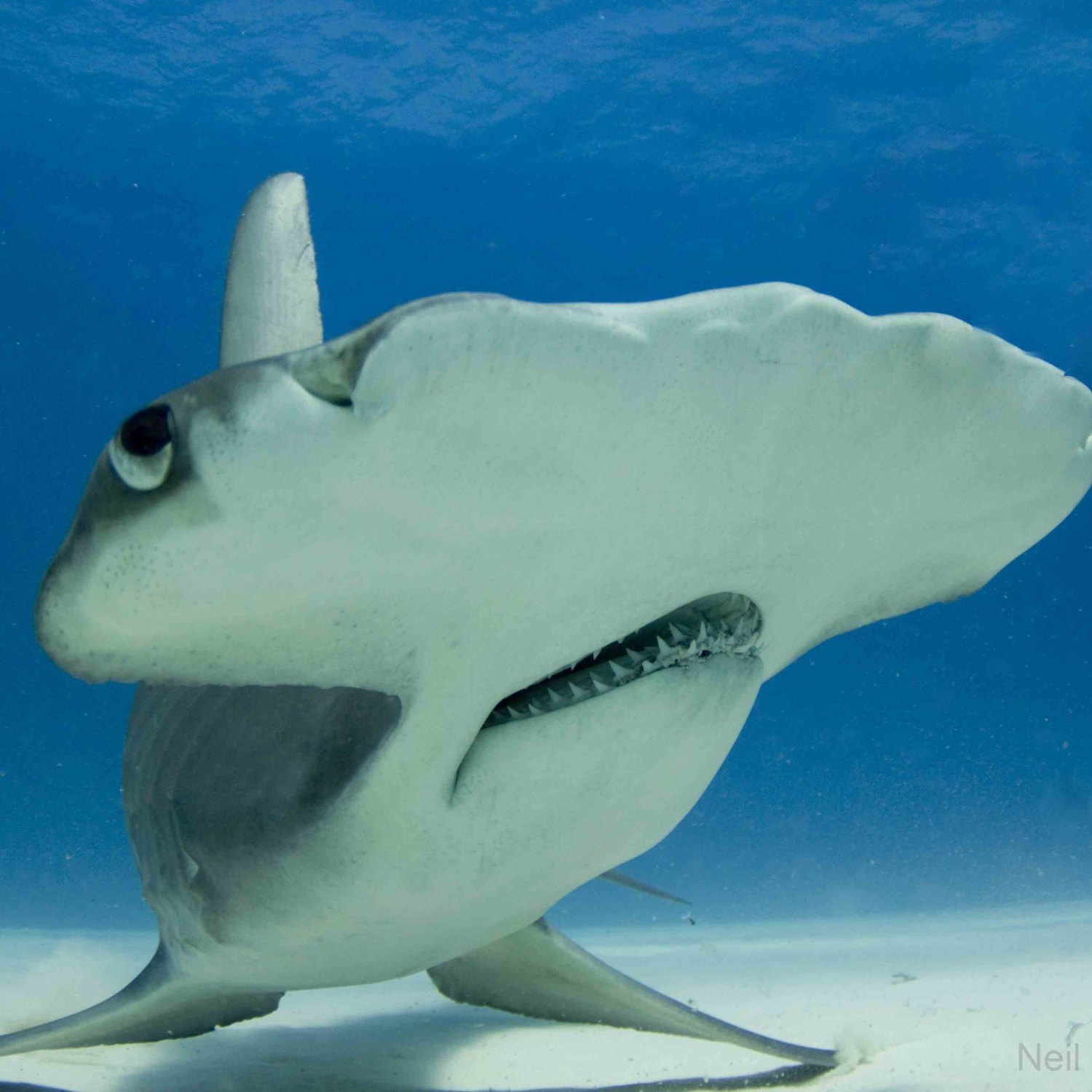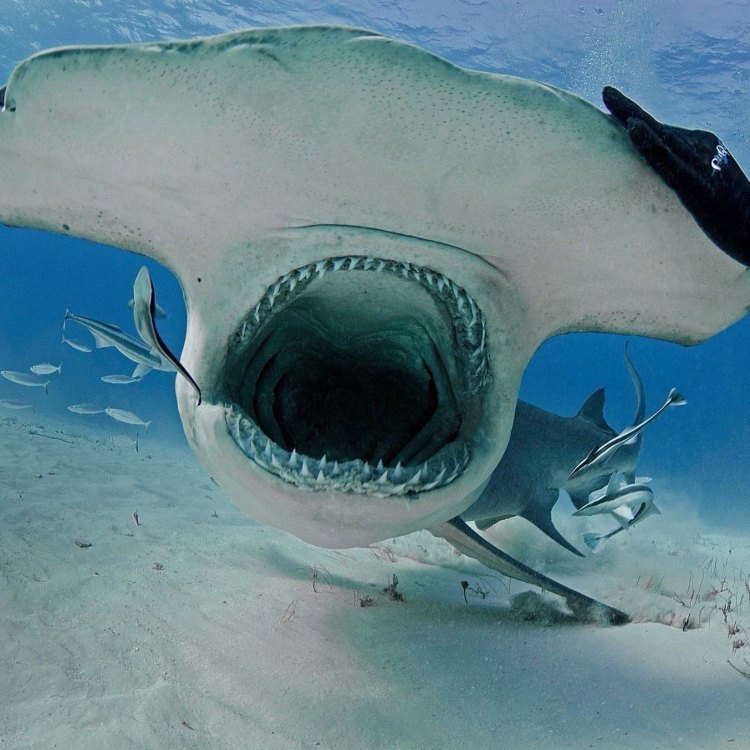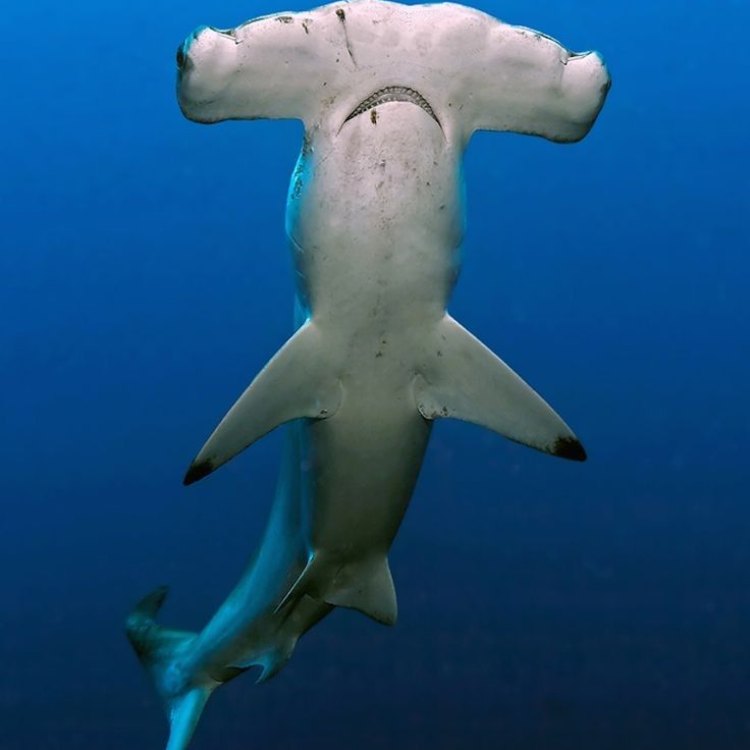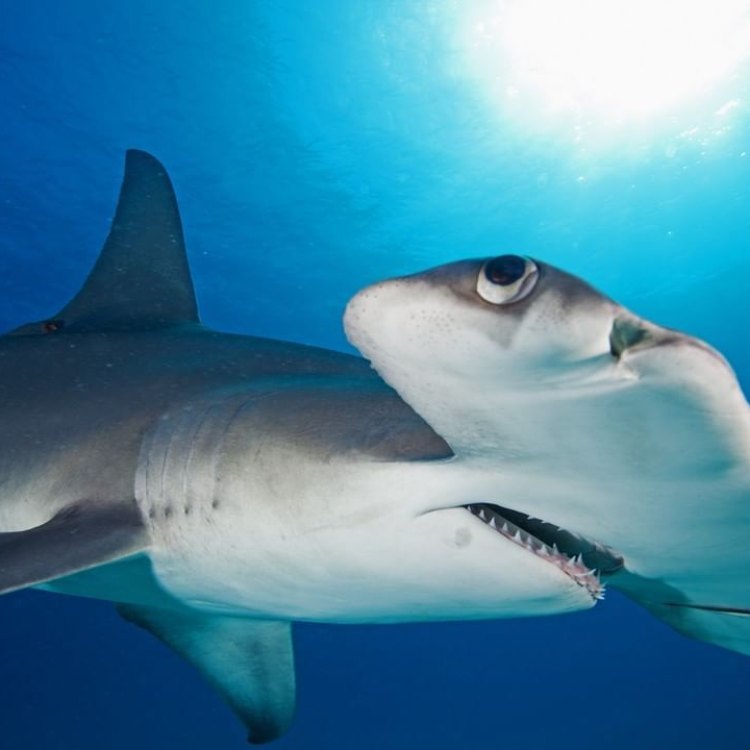
Hammerhead Shark
Up to 20 feet (6 meters)
The Hammerhead Shark, known for its distinct head shape, can grow up to 20 feet and weighs around 500 pounds. Found in coastal areas, it belongs to the Sphyrnidae family and has a cylindrical and slender body. These powerful predators play a vital role in maintaining the balance of marine ecosystems. #HammerheadShark #CoastalAreas #MarineEcosystems
Animal Details Summary:
Common Name: Hammerhead Shark
Kingdom: Animalia
Habitat: Ocean
The Magnificent Hammerhead Shark: A Fascinating Ocean Predator
The ocean is home to some of the most fascinating and mysterious creatures, and the Hammerhead Shark is no exception. With its unique appearance and impressive abilities, it is no wonder that this species has captured the hearts and minds of people all over the world. In this article, we will dive deep into the world of the hammerhead shark, exploring its scientific characteristics, habitat, behavior, and more.The Science Behind the Name
One of the most distinctive features of the Hammerhead Shark is its head, which is shaped like a hammer Hammerhead Shark. This is reflected in its scientific name, Sphyrna mokarran, where "sphyrna" means "hammer" in Greek. The common name, hammerhead shark, is derived from its unique appearance as well.The Hammerhead Shark belongs to the kingdom Animalia, which includes all living animals. It falls under the phylum Chordata, which includes vertebrates with a spinal cord. The class for this species is Chondrichthyes, which includes all cartilaginous fish such as sharks, skates, and rays. Within this class, the hammerhead shark belongs to the order Carcharhiniformes and the family Sphyrnidae, along with eight other species of hammerhead sharks.
A Habitat Fit for a Predator
The Hammerhead Shark is a true ocean dweller and can be found in tropical and warm temperate waters all around the world. It is a highly migratory species and can travel great distances to find food and mates. In fact, these sharks can swim up to 415 miles (668 km) in just a few days, making them one of the most mobile shark species Hairy Frogfish.These predators are known to inhabit both coastal areas and the open ocean, with some species preferring one over the other. They can be found in depths ranging from a few feet to more than 1,000 feet (305 m). One unique behavior of the hammerhead shark is that they tend to stay in groups, often swimming in large schools. These schools can consist of up to several hundred individuals, making for an impressive sight.
A Carnivorous Diet
As with all sharks, the Hammerhead is a carnivore, meaning it primarily feeds on other animals. Its diet consists mainly of fish, such as sardines, herring, and mackerel, but they also feed on other sharks, rays, and sometimes even squid. These predators have been known to consume prey up to half their body size, and their unique head shape plays a crucial role in their feeding behavior.The hammerhead shark's wide-set eyes give it a 360-degree view, making it easier for them to spot prey. The placement of their eyes also gives them improved depth perception, allowing them to pinpoint their prey's exact location. Furthermore, their wide head helps with their sharp sense of smell, allowing them to detect even the slightest scent of prey. These adaptations make the hammerhead shark an apex predator, at the top of the food chain in its habitat.
Geographical Distribution and Country of Origin
The Hammerhead Shark is found in many countries all over the world, including the United States, Australia, Brazil, China, and India, to name a few. As mentioned earlier, they are highly migratory, and their exact geographical distribution can vary based on the time of year and their seasonal migrations. One unique characteristic of this species is that they have been found in both saltwater and freshwater environments, demonstrating their impressive adaptability.A Gray-Brown or Olive-Green Coloration
The hammerhead shark's coloration is crucial to its survival, allowing it to blend in with its surroundings and remain camouflaged from potential predators. The top of their body is generally gray-brown or olive-green, while their underside is lighter in color, making it difficult to spot them from above or below. This feature is an advantage when hunting, as the hammerhead can sneak up on its prey without being easily detected.The Sleek and Powerful Body Shape
One of the most impressive physical characteristics of the hammerhead shark is its body shape. These predators have a cylindrical and slender body, making them incredibly streamlined and efficient swimmers. They have five to seven gills on each side of their head and a dorsal fin that extends the length of their back, providing extra stability and balance while swimming.The hammerhead shark's body can reach up to 20 feet (6 meters) in length and weigh up to 1,000 pounds (450 kg). This size and weight make them one of the largest shark species on the planet. However, despite their size, they are still agile and swift underwater, capable of reaching speeds of up to 24 miles per hour (38 km/h).
The Importance of Conservation
While the hammerhead shark is a powerful and fascinating creature, it is also facing numerous threats that are endangering its population. Overfishing, pollution, and habitat loss all pose significant risks to this species. Additionally, hammerhead sharks are often caught unintentionally by commercial fishing operations, leading to a decline in their numbers.Fortunately, many conservation efforts are underway to protect the hammerhead shark and its habitat. These include the creation of marine protected areas and the implementation of fishing regulations to limit the number of hammerhead sharks caught. Raising awareness about these threats and educating the public on how to be responsible ocean inhabitants is also crucial to preserving the hammerhead shark for future generations.
The Hammerhead Shark in Popular Culture
The hammerhead shark's unique appearance and behavior have made it a popular figure in popular culture. It has appeared in many forms of media, including books, movies, and even video games. The most famous representation of this species is likely in the book and film series, "Jaws," where a large hammerhead shark terrorizes a coastal town. However, in reality, hammerheads are not aggressive towards humans, and attacks are extremely rare.In Conclusion
The Hammerhead Shark is undoubtedly a remarkable creature, with its distinctive head, impressive physical abilities, and crucial role in the ocean ecosystem. This species has captured the fascination of millions of people worldwide and continues to be a subject of research and conservation efforts. As our understanding and appreciation for the ocean and its inhabitants continue to grow, we must remember to protect and preserve species like the hammerhead shark for future generations to admire and study.

Hammerhead Shark
Animal Details Hammerhead Shark - Scientific Name: Sphyrna mokarran
- Category: Animals H
- Scientific Name: Sphyrna mokarran
- Common Name: Hammerhead Shark
- Kingdom: Animalia
- Phylum: Chordata
- Class: Chondrichthyes
- Order: Carcharhiniformes
- Family: Sphyrnidae
- Habitat: Ocean
- Feeding Method: Carnivorous
- Geographical Distribution: Tropical and warm temperate waters
- Country of Origin: Various countries
- Location: Coastal areas
- Animal Coloration: Gray-brown or olive-green
- Body Shape: Cylindrical and slender
- Length: Up to 20 feet (6 meters)

Hammerhead Shark
- Adult Size: 10 to 14 feet (3 to 4.3 meters)
- Average Lifespan: 20 to 30 years
- Reproduction: Ovoviviparous
- Reproductive Behavior: Mating occurs inshore
- Sound or Call: Unknown
- Migration Pattern: Year-round migration
- Social Groups: Solitary or in small groups
- Behavior: Nocturnal and highly migratory
- Threats: Overfishing and habitat destruction
- Conservation Status: Endangered
- Impact on Ecosystem: Maintains balance in marine food chains
- Human Use: Commercial fishing, ecotourism
- Distinctive Features: Unique hammer-shaped head
- Interesting Facts: 1. Hammerhead sharks have a 360-degree field of vision. 2. They use their hammer-shaped head to enhance their hunting abilities. 3. Some species of hammerhead sharks are known to migrate long distances.
- Predator: Orcas, larger sharks

Sphyrna mokarran
The Mighty Hammerhead Shark: A Master of the Ocean
The ocean, covering nearly 71% of the Earth's surface, is still full of mysteries waiting to be explored. Within the deep, dark depths of the sea lies a creature that has captivated and intrigued humans for centuries - the hammerhead shark. With its unique features and impressive abilities, the hammerhead shark is truly a marvel of nature.Adult hammerhead sharks can grow to be 10 to 14 feet long, with some species even reaching lengths of up to 20 feet PeaceOfAnimals.Com. They can weigh anywhere from 500 to 1,000 pounds, making them one of the largest shark species in the world. Their distinctive hammer-shaped head, known as a cephalofoil, sets them apart from other sharks and makes them easily recognizable.
But size and appearance aren't the only things that make hammerhead sharks fascinating. Their average lifespan of 20 to 30 years is impressive for a wild animal, and they have unique reproductive behavior that adds to their mysterious nature.
Hammerhead sharks are ovoviviparous, meaning that the females hold fertilized eggs inside their bodies until they hatch, giving birth to live young. They can give birth to anywhere from 12 to 40 pups at a time, depending on the species. This reproductive strategy allows for a higher survival rate among the offspring, as they are protected inside the mother's body until they are fully developed.
Mating for hammerhead sharks typically occurs in shallow water areas, like inshore bays and reefs. This behavior is thought to decrease the chances of predators attacking the vulnerable pregnant females Hoopoe. It is also believed that mating inshore provides the mother with a steady food supply, ensuring she can provide for her growing young.
Interestingly, not much is known about the sound or call of hammerhead sharks. Unlike some shark species that are known for their vocalizations, hammerheads haven't been known to produce any distinct sounds. This could be due to the limited research on their communication methods.
One thing that is known about hammerhead sharks is their year-round migration pattern. These creatures are highly migratory and can travel long distances, sometimes covering thousands of miles. Some species of hammerhead sharks are known to travel between the Gulf of Mexico and the Caribbean, crossing the Atlantic Ocean. Their reason for migration is not fully understood but is believed to be linked to their feeding and reproductive habits.
When it comes to behavior, hammerhead sharks are mostly solitary or found in small groups. They are also nocturnal, meaning they are most active at night. This behavior is thought to be an evolutionary adaptation that helps them avoid predators and increase their chances of catching prey. They are also highly migratory, often making long journeys during the night hours, which further supports their nocturnal behavior.
But what makes hammerhead sharks truly unique is their distinctive head shape. It is believed that the hammer-shaped head gives them a 360-degree field of vision, allowing them to see above and below them simultaneously. This gives them an advantage when hunting, as they can detect prey from all angles. Additionally, their head acts as a flat surface, helping to enhance their electrosensory system, which allows them to detect the electrical signals emitted by their prey.
Their hunting abilities are further enhanced by their exceptional sense of smell, which helps them locate prey from long distances. They are at the top of the food chain in their marine ecosystem, preying on a variety of fish, including stingrays, squid, and smaller sharks.
Despite their impressive abilities, hammerhead sharks are not invincible. They have a few natural predators, including orcas and larger sharks. However, the biggest threat to these creatures is humans. Overfishing is a significant concern, as hammerhead shark fins are considered a delicacy in some countries, leading to a significant decline in their populations. Additionally, their habitat is being destroyed due to human activities such as pollution and coastal development.
Due to these threats, hammerhead sharks are classified as endangered on the IUCN Red List. Their decline not only affects their species, but it also has an impact on the entire marine ecosystem. As top predators, hammerhead sharks play a crucial role in maintaining the balance in their food chains. Without them, there could be a ripple effect that leads to significant changes in the ocean's ecosystem.
Human use of hammerhead sharks is not limited to overfishing unfortunately. These creatures are also sought after for ecotourism purposes. Many people are drawn to the mystique and uniqueness of these sharks, leading to an increase in activities such as shark diving and cage encounters. While these activities can bring awareness and appreciation for hammerhead sharks, they need to be done responsibly to ensure the safety and conservation of the species.
In conclusion, the hammerhead shark is a truly remarkable creature that continues to fascinate and amaze us. From its impressive size and lifespan to its unique reproductive behavior, it is clear that these sharks have adapted to thrive in their marine habitat. However, as with many other marine animals, they face numerous threats from human activities. It is crucial that we take action to protect these creatures and their ecosystem to ensure they will continue to roam the oceans for future generations to admire and study. So, the next time you catch a glimpse of a hammerhead shark, take a moment to appreciate its magnificence and the essential role it plays in the ocean's delicate balance.

The Magnificent Hammerhead Shark: A Fascinating Ocean Predator
Disclaimer: The content provided is for informational purposes only. We cannot guarantee the accuracy of the information on this page 100%. All information provided here may change without prior notice.












